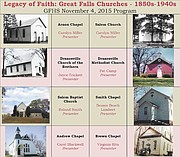On Wednesday evening, Nov. 4, The Great Falls Historical Society program provided a panoramic view of the founding and early beginnings of historic churches throughout an area currently known as Great Falls. The march of people of faith toward Great Falls began well before the civil war in some faiths, but seemed to manifest its greatest expressions in the area in the decade just prior to the civil war (1861-1865), or just at the turn of the century that followed. The story of each local church shares the longing for a place of worship and the importance of building a specific place for the life of the community of faith to take root and grow. Here are some of the highlights:
- Andrew Chapel, 1854 – Carol Blackwell
A chapel is a church that bears a family name. Andrew Chapel, founded in 1854, was occupied by Yankees and damaged during the civil war. It was rebuilt in 1869 by its 51 members, which grew to 80 members by 1871 – including the Follin family, the Money family, and the Gunnell family, among others - and was later renovated in 1907. The church was served by a circuit of ministers and did not have a full-time minister until 1957.
- Brown’s Chapel, 1850 – Virginia Rita
At 76 years old, Reverend Jesse Brown and his wife Abigail came to the Leesburg Pike area with their 44-year old son, Augustus and 2 other ministers and purchased a 317-acre farm that spanned both sides of the Leesburg Pike, now known as Colvin Run Road, for $12 per acre. Both Jesse and Augustus had preaching licenses. The first worship service in Brown’s Chapel took place in 1879. They worshipped in the Liberty Church prior to that. Brown’s Chapel was moved to the entrance of Reston on May 3, 1968 to save the chapel, after 90 years of fine religious use.
- Dranesville Church of the Brethren, 1905 - Joyce Trickett
The worshippers who would later establish this church on Georgetown Pike originally came from Germany in 1708, via Lancaster, Pa. in 1719, then Prince William County in 1904. The Church of the Brethren site was established in 1905. Prior to building the church, they prayed at home in fellowship, then met at the Liberty Meeting House, where they met one Sunday per month. They built their own church in one year on the site of the Battle of Dranesville, where union forces fought on Dec. 20, 1861 – at one of the opening skirmishes of the civil war. They conducted their first service on Oct. 27, 1912. Each year on Dec. 20 they conduct a peace service, recalling the men who lost their lives in the Civil War battle at that location.
- Dranesville Methodist Church 1852 – Pat Camp
The first chapel of the Dranesville Methodist Church, a small log cabin, was built at Sugarland Run in 1786. In 1790, the chapel was relocated to land granted to James and Eliza Coleman. Referred to as the Liberty Meeting House, the chapel was deeded for public use, free for all denominations and for the education of youth. The first class was held in 1852. In 1861, 161 men were killed during the civil war and the church was used as a hospital.
- Salem Baptist Church, 1903 – Roland Smith, Pastor
After the Civil War, Lettie Ford Ellis walked from Louisiana to Dranesville to her home near Seneca Road. In 1903, she dedicated a one-acre portion of the property given to her to build a church. Recently collapsed, there are plans to rebuild the church with the intention of sharing the new construction with the entire neighborhood, across all denominations.
- Smith Chapel, 1890 – Beanie Beach Lambert
Jesse Smith came from Mainstone, England, via New York and was a carpenter by trade. Starting in 1985, Jesse Smith attended the Liberty Meeting Hall. In 1861, Abraham Lincoln was elected President and one month later the Civil War began. There was a skirmish that took over the Dranesville Church, took crops and chickens. After the war the Smith Chapel was built. Beanie Lambert’s great-grandmothers worshiped at the church.
- Salem Church, 1877 – Carolyn Miller
In 1854, Charles Whittier of the Methodist Protestant Conference conducted prayer meetings in homes. In 1876, they made plans for a permanent house of worship and in 1877 they dedicated the new church. The Follins, Hendersons, Cornwells, Sanders, Winstons and others worshipped at this church. Ann Stark Cornwell wrote about Christmas at Salem Church in her book, “Grandpa’s Shadow.”
- Arnon Chapel, 1893 – Carolyn Miller
Annie Johnson built Arnon Chapel. They cut trees from the property, and built the chapel. The bark of the oak trees can still be seen in the basement of the building. It was opened as Forestville, but in 1893, the name was changed to Arnon. Carolyn’s grandmother had a Sunday School class. When Carolyn’s grandfather heard that the name was Arnon, he left the new church and returned to Salem.
